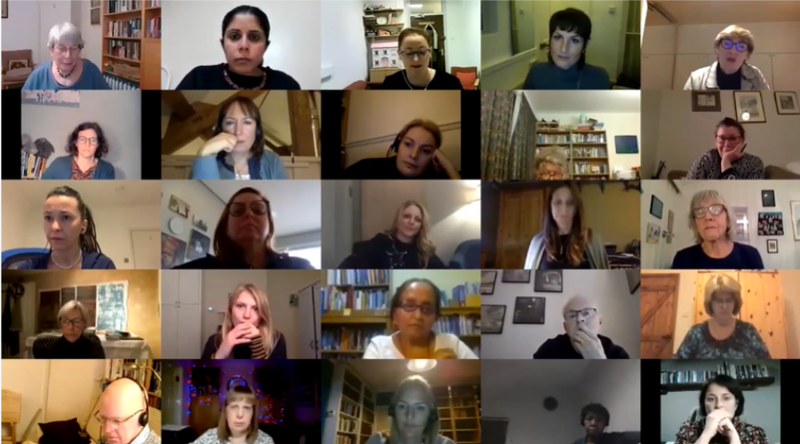
News
“The unconscious is a foreign country we are training to get to know”
Over 500 participants joined our centenary talk with Dilys Daws and Alex de Rementeria on the legacy of Esther Bick earlier this week.
It was a rich and multi-layered discussion that brought alive the inspirational nature of infant observation – today just as when first developed by Bick and introduced to child psychotherapy training in the 1940s. It also gave a vivid picture of a legacy passed down by oral tradition: Dilys was taught by Esther Bick, Alex was taught by Dilys; and the passion and enthusiasm of Alex’s own students on the Psychoanalytic Observational Studies Course (M7) came across vividly in their accounts of “an amazing experience” that creates awareness of “the value of noticing the smallest things.”
It was remarkable too to hear about the transmission of a family tradition in Dilys’ own observation: the sister of her observed baby James was a mother of a baby who was observed by Kate Steiner, who went on to curate an interactive gallery for children in London’s Science Museum.
“I could write a book just about one observation” (Rohima, M7 student)
The learning in infant observation comes from watching and noticing the uniqueness of each mother-baby couple. Dilys described how in discussion about the baby she was observing, James, Bick drew attention in the seminars to kinaesthetic patterns in his touching of his mother’s breast and hands while feeding. Bick developed her thinking about these patterns and the parallels between physical and psychological connection in her classic paper Notes on Infant Observation in Psycho-Analytic Training (1964), in which Dilys’ observations of James feature centrally.
Learning to pay attention to every observed detail, for Dilys, was part of learning a critical stance: not coming in with predetermined solutions but always remaining curious. Alex linked this stance with her work in a clinic for children with autistic spectrum difficulties where her colleague Adele O’Hanlon spoke up for “learning to keep uncertainty alive and useful.” Alex went on to speak movingly about how, in her observation training, she had been able to come to understand psychoanalytic theories from life – by identifying with the infant she was observing. Continuing the theme of the value of training in infant observation for later clinical work, Dilys commented that this way of being with the family helps the developing clinician with learning where to put yourself, where to sit or stand, how to be. A question from Sarah Wheatley during the discussion brought another important aspect of the learning from infant observation to the fore: helping us to bear what is painful in what we observe, giving attention to the negative as well as the positive. Sustained by hopefulness that comes from close observation of the growth-promoting drive for development, the clinician can help parents to be both more curious, and more hopeful, about their baby.
“Don’t just do something, stand there”
This widely-attributed quote links to a theme that resonated for both speakers and for participants about the value of observation for the child, the parents and the family. Dilys spoke of how “the observing glance is the basis for consultation in the baby clinic”: she described how some mothers wrapped their babies in their voice and gaze when they were being weighed, while other babies were more exposed. Putting feelings into words and making connections enables pre-verbal babies to feel understood and contained. Seeing this process in action can be so helpful for parents as they are getting to know their infants.
“The magic of just being thought about”
What the child can take from the experience of being observed – what the parents can gain for their own observation and curiosity about their child – these incidental, unexpected benefits of infant observation have led to the introduction of therapeutic observation as an intervention to support children and families. The Watch Me Play! approach also has its roots in psychoanalytic infant observation and the recognition of the value for the baby or child of being “wrapped” in a parent’s gaze, or the gaze of a benign, non-judgmental observer.
Infant observation in the time of Covid-19
It was right that a talk at the end of 2020 should address the topic of infant observation carried out by Zoom, as most observations currently are. Dilys’ response to a question on this topic was characteristically pragmatic and straightforward: “It is less, but it is what it is available”. She agreed with Alex that it has been surprising to see how much can happen through online methods and how much can be experienced in work carried out remotely. Indeed these ways of working – already more familiar to colleagues in countries where distances are greater – are broadening our ways of working, as another audience member commented, while retaining the essential depth of learning to “see with meaning.”
Alex paid tribute to Dilys’ generosity of spirit as well as her deep understanding as a clinician and as a teacher. I’d like to put on record my own gratitude to Dilys, as my observation tutor, and for her inspiring example of steadfast rigour, mixed with humour and hopefulness. It was wonderful on Monday evening to see the hopefulness and passion for learning that infant observation continues to inspire in each generation of new students.
